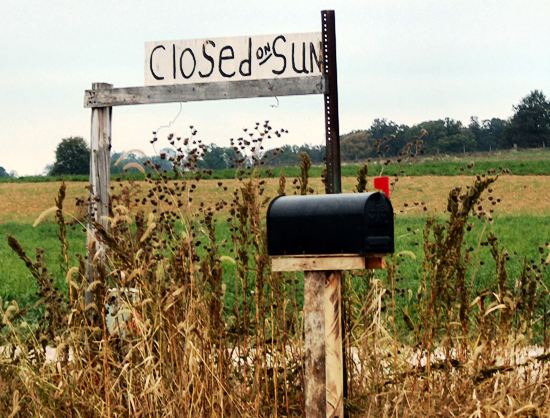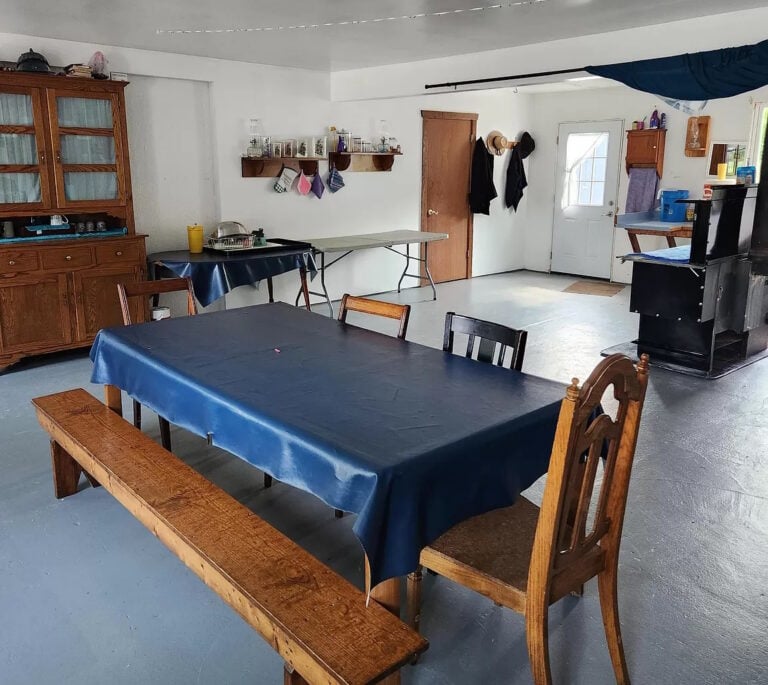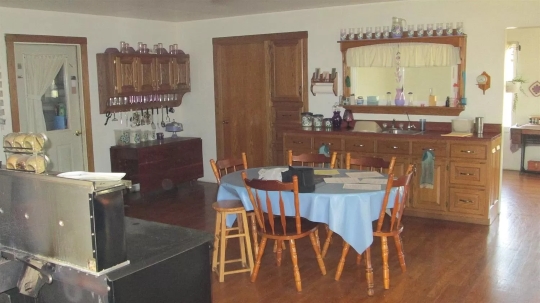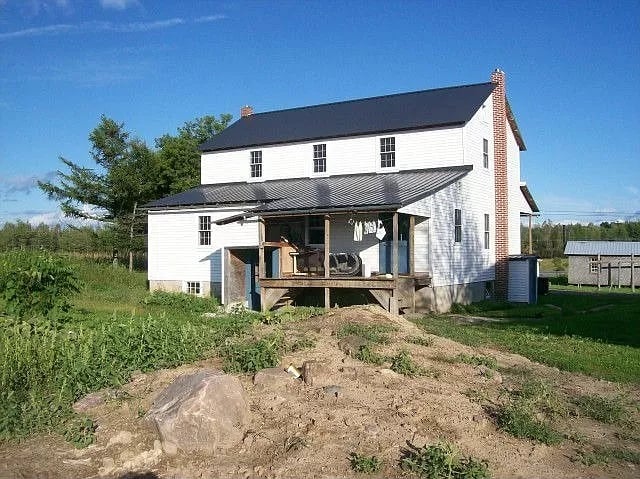How The Plainest Amish Heat Water
Hot water on demand – for showers, dishwashing, laundry – is something most of us take for granted. Yet, there is a small segment of people in the US today who do not enjoy such a luxury. This would include the most conservative Amish churches.
Below you’ll find some photos sent in by reader Maxwell Hodgkins of a laundry room in a plain Amish home in Michigan. You can see the setup and find an explanation of how they heat their water. Note: this is an example of a very traditional home. Amish in less plain groups would heat water by other methods and would have a standard hot water tap in their bathrooms and kitchens.

The reader explains that there are three steps in the process. First, the tank at top is just a holding tank.

It is fed by a well. Water is pumped up to the tank using a gas engine.

The stove for heating the water is made of stainless steel. Most of the homes in this community have them.
The firebox below the water tank (one unit) burns wood. Once the water in the drum is heated, it is then ladled with a bucket, or drained from the spigot into the basin.

Afterwards the water is then transferred by bucket to the washing machine. The machine is powered by a Honda engine outside using a drive shaft and pulley.

Here is a square hanger with clothes pins for hanging laundry for drying after the process is complete.

Thanks to the anonymous reader sharing these photos. Nice example here showing how Amish in the plainest communities heat their water. Water heated by this process could also be used for bathing.
How good we’ve got it (say non-Amish…and other Amish too)
When you see a setup like this, it makes you appreciate even more, how easy we non-Amish have it, being able to just turn a tap and luxuriate in perfectly-heated H2O for bathing and other purposes. Likewise, other Amish groups, who use more modern forms of plumbing and water heating, would feel similarly about going to this much trouble to acquire hot water.
Yet the more tradition-minded groups err on the side of the way things have been done in the past. While the water is heated by burning wood, a method thousands of years old, at the same time they are using a decidedly modern device (diesel engine) to pump the water to the tank and to power the washer.
This is an example of why over-simplifying the Amish to “living in the past” is a mistake. It’s more about evaluating and accepting or rejecting technologies on their merits. And, with some groups being more reluctant to accept innovations than others (though all Amish change over time, just at different speeds). It can lead to some combinations like this that outsiders might find “nonsensical” or even “hypocritical“.
As to the drive shaft and diesel engine system, I’ll have a video showing that soon. It’s a power setup used by the plainest groups for powering appliances and shop tools. You can also see examples in Amish workshops here and here.









To outsiders the Ordnung seems (and may in fact be) illogical, capricious, inconsistent and all the rest, and yet the Amish believe there is a sound doctrinal principle behind each and every rule. Apparently lost in consideration, however, is the toll placed on the environment inherent in many of these Plain customs, albeit unintentional. Surely, care of God’s creation, this relatively small planet in all the known universe that sustains us, should be top of mind for all of us in the ways we live our lives, whether Amish or atheist.
My favorite observation
Erik, I’m not as interested in how the Amish heat water as you. However, my all time favorite observation or comment from you is: “. . . all Amish change over time, just at different speeds.”
I’ll put that in my hip pocket and use it some day in my own writing.
Thanks, Jim
How the Plainest Amish Heat Water
This method is similar to what I see in my Troyer Amish friends’ homes, minus that clever holding tank. It is simple, reliable, renewable. When a big storm hits, as it is doing here today, and the electric power goes out, they are warm, safe, comfortable and carrying on with their daily, productive activities. This will be one of my next upgrades to my very rustic cabin. They also use these water heaters as giant canners in the summer. Some of them can hold at least 60 quart jars at one time. They move them outside so the house isn’t so hot. It’s way more efficient than my relatively little kettle/pressure canner. Thanks for sharing the photos.
Heating water
Oh my gosh that looks to be complicated. Be so simple to just install a nice clean bathroom heat water with hot water tank. Goodness I’m sure our lord wouldn’t object our ways for simpler life style. Using modern plumbing isn’t going to make you a bad person. Maybe the way shown is from a very old amish tradition and now they advanced like some using a tractor etc. Was very interesting thank you for sharing.
That drying rack is a good idea for small stuff. I may have to make one (my laundry all gets air-dried).
Do their kitchen cookstoves have the hot water attachment? I can’t remember seeing any on the homes you’ve showed us. For those who don’t know, this is just an enclosed basin attached to one side that you fill with water, and voila, hot water any time you’ve had the stove hot.
Modern Plumbing
Using a modern plumbing system would solve a large problem in the community. What to do with the accumulated human waste. If a household has a septic tank, the people in my area simply pump the human waste onto a field or into a ditch. Not sanitary, not safe. Or in even older communities the outhouse pollutes the ground water. Pick your poison, literally.
reply
ok ive seen this in wisconsin at my bosses parents house they have a kettle which they heat up the water with
Not just the Amish...
I was laughing somewhat at this. I couldn’t be further from taking running hot water for granted!
I have just spent slightly more than three years living in a house where the only built in sources of hot water were an electric shower and the open fire (which thankfully had a connected back boiler to a hot water tank). Long story, but has to do with being messed about over a disabled facilities’ grant (in UK). Admin went round in circles for more than a year with all sorts of catch-22s: I was never sure if they were just incompetent or actually trying to dodge obligations.
The builder employed to do the adaptions, bless him, wasn’t having it that I didn’t need hot water, which had been left out of the kitchen adaption plans, probably by mistake (easy enough if someone hadn’t twigged the lack of central supply), and made a duty-of-care fuss.
I now have a local electric water heater on a kitchen tap and I keep forgetting I have hot water if I want it and washing up in cold like I used to!
My mother, when she visited, used to boil the kettle to wash up, but I found it too difficult to do safely and used to do the best I could without. I was incredibly grateful for the electric shower – with the particular medical condition I have, it isn’t safe for me to bathe in cold water so I would have been really struggling without that. And – again very fortunately – the washing machine I had happened to heat its own water anyway. Which does put me in a much higher technological position than using wood heat for baths and laundry, I suppose, though probably lower on the fact that the wood heated water is from an open fire not a stove and the water delivery system to the taps is natural pressure only. I’m sure I’ve seen at least one picture on this website where the people in a particular house had a hand-worked pump by the sink, though?
This sort of lack of what most people assume everyone can take for granted if they want it isn’t uncommon for people with disabilities, either: mine is not some sort of unique, unusual freak case. I can’t remember how long a wheelchair-using friend of mine was left entirely without bathing facilities she could use in her home, for much the same reason. I think it was months rather than weeks, and even then, she certainly dealt with a limited access interim situation for more than a year.
In the no-access stage, she had to struggle to a gym some way away several times a week simply to get a basic wash. Houses are not built accessible, and there is almost no accessible rental in England, so you tend to have to move in and deal with it for as long as it takes to sort out, which is often much longer than anyone who hasn’t had to try to get it sorted out would dream it could take (https://handmaidsdistaff.wordpress.com/2022/02/17/to-shower-or-not-to-shower-a-game-of-spot-the-difference/).
Some Amish have no running hot water as a lifestyle choice. The disabled get landed with it partly because of their genuinely complexities and partly due to people’s random faffing about. I wonder which other groups in the Western world actually, without it being generally apparent to others, end up in the same situation?